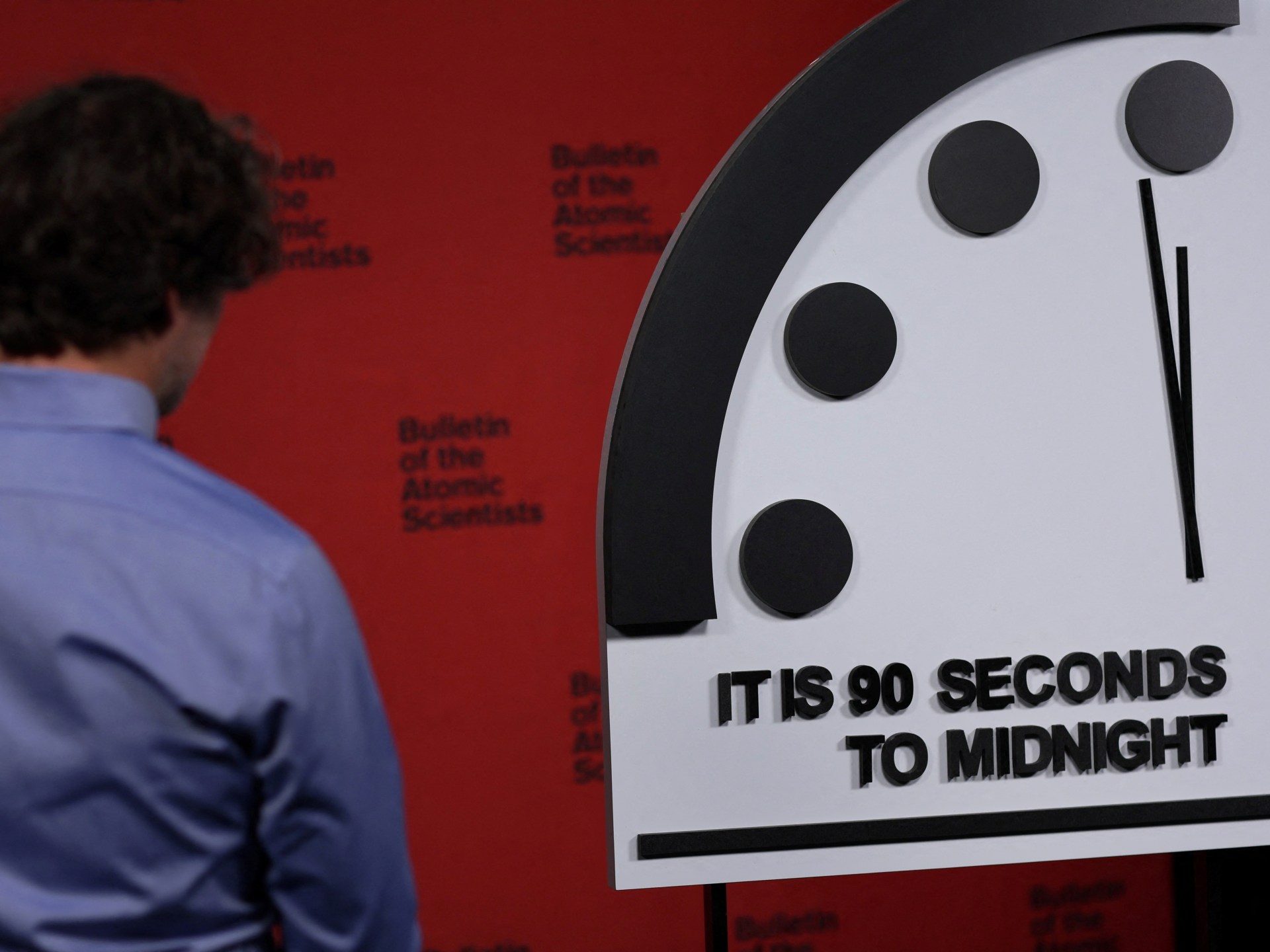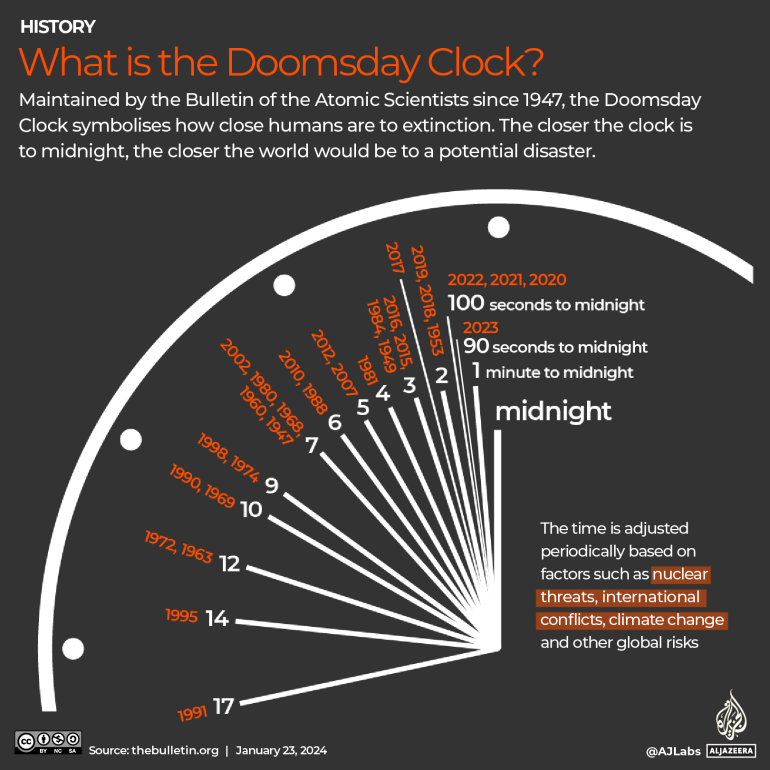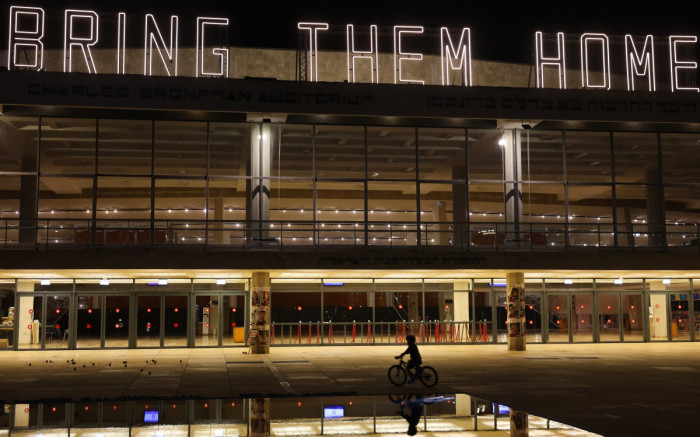
Nuclear scientists have set their doomsday clock at 90 seconds to midnight, as they did last year, citing concerns about Russia’s possible use of nuclear weapons during its invasion of Ukraine, Israel’s war on Gaza and worsening climate change as factors raising the risk of a global catastrophe increase .
Here’s what we know about Doomsday Clock and Tuesday’s announcement:
What did the Bulletin of the Atomic Scientists announce?
Scientists kept their doomsday clock close to midnight, setting it later than ever before in its 77-year history.
“Conflict hotspots around the world pose the threat of nuclear escalation, climate change is already causing death and destruction, and disruptive technologies like AI and biological research are advancing faster than their safeguards,” said Rachel Bronson, president and CEO of the Bulletin, adding that The hands of the clock, which have remained unchanged compared to the previous year, “are not an indication that the world is stable.”
What wars and conflicts led to this announcement?
of Russia large-scale invasion of UkraineSet to celebrate its second anniversary next month, tensions with the West have escalated to their most dangerous levels since the Cold War.
“A permanent end to Russia’s war in Ukraine appears to be a long way off, and Russia’s use of nuclear weapons in that conflict remains a serious possibility.” “Over the past year, Russia has sent numerous worrying nuclear signals,” Bronson said.
Bronson pointed to Russian President Vladimir Putin’s decision in February to suspend Russian participation in the New START Treaty with the United States, which limited the two countries’ strategic nuclear arsenals.
The United States and Russia together have nearly 90 percent of the world’s nuclear warheads, enough to destroy the planet many times over.
Bronson also pointed to Putin’s announcement in March that Russia would station tactical nuclear weapons in Belarus and the Russian parliament’s passage of a law in October withdrawing ratification of the global treaty banning nuclear weapons tests.
Israel has been at war with Hamas since the Gaza-based Palestinian group Attacks launched in southern Israel on October 7th.
“As a nuclear state, Israel’s actions are clearly relevant to the doomsday discussion. “Of particular concern is that the conflict in the region could further escalate, leading to larger conventional war and attracting more nuclear or nuclear-aligned powers,” Bronson said.
Climate change was also taken into account.
“The world entered uncharted territory in 2023 as it experienced the hottest year on record and global greenhouse gas emissions continued to rise,” Bronson added.
“Both global and North Atlantic sea surface temperatures broke records, and Antarctic sea ice reached its lowest daily extent since the advent of satellite data.”
Bronson said 2023 was also a record year for clean energy, with $1.7 trillion in new investments. But that was offset by nearly $1 trillion in fossil fuel investments, Bronson said.
Her organization also warned against artificial intelligence.
“AI-powered disinformation efforts could be a factor preventing the world from effectively dealing with nuclear risks, pandemics and climate change,” said a press release added.

What is the Doomsday Clock?
The Doomsday Clock is a symbolic clock that shows how close we are to “destroying our world with dangerous technologies of our own making,” according to the Noticea Chicago-based nonprofit that controls the clock.
The Bulletin describes it as “many things at once: it’s a metaphor, it’s a logo, it’s a brand and it’s one of the most recognizable symbols of the last 100 years.”
The closer it gets to midnight, the closer humanity is to the end of the world.
Apocalyptic threats could arise from political tensions, weapons, technology, climate change or pandemics.
How is the clock set?
The clock’s hands move closer to midnight or further away from midnight at any given time, depending on scientists’ assessment of existential threats.
The bulletin updates the time annually. A panel of scientists and other experts in nuclear technology and climate science, including ten Nobel Prize winners, discusses world events and decides each year where the clock’s hands should be placed.
“The Bulletin is a bit like a doctor making a diagnosis,” the organization said on its website.
“We look at data the way doctors look at lab tests and X-rays, and also consider factors that are harder to quantify, the way doctors do when they talk to patients and family members. We consider as many symptoms, measurements and circumstances as possible. “We then come to a verdict that summarizes what could happen if leaders and citizens do not take action to treat the diseases,” it continues.
Today, the Bulletin’s Science and Safety Committee is once again setting the course #DoomsdayClock at 90 seconds to midnight.
Humanity continues to face unprecedented danger.
Read the full statement: https://t.co/PowB7RkzXw pic.twitter.com/aRyF2ZX3wB
— Bulletin of Atomic Scientists (@BulletinAtomic) January 23, 2024
Can we still turn back the clock?
According to the bulletin, it is possible and it has happened before.
However, for this to happen, the Bulletin recommends that “three of the world’s leading powers – the US, China and Russia” begin a serious dialogue.
“You have the ability to save the world from the brink of disaster. They should do so with clarity and courage and without delay,” the statement said.
When was the Doomsday Clock created?
The Clock was created 1947 from the Bulletin, founded two years earlier by scientists Albert Einstein, J. Robert Oppenheimer and Eugene Rabinowitch, as well as scientists from the University of Chicago.
At the time, the clock was set at seven minutes to midnight, but after the Soviet Union successfully tested its first atomic bomb in 1949, Rabinowitch, then editor of the Bulletin, set the clock at three minutes to midnight.
The clock’s longest distance from midnight was 17 minutes. That was in 1991, when US President George HW Bush and Soviet leader Mikhail Gorbachev signed the Strategic Arms Reduction Treaty (START) to reduce their countries’ number of nuclear weapons and ballistic missiles.
According to the University of Chicago, until recently this value was the lowest ever recorded two minutes to midnight: in 1953, when the United States and the Soviet Union tested thermonuclear weapons, and in 2018 due to “a breakdown in the international order, nuclear actors, and the continued lack of action on climate change.”
Then, in 2023, the clock moved It’s the closest time to midnight – just 90 seconds away. The organization said the update was made “largely (though not exclusively) due to the growing dangers of the war in Ukraine.”
“The likelihood that the conflict could spiral out of control remains high,” Bronson said.
The Doomsday Clock is posted in the University of Chicago Bulletin Offices.
The 2024 #DoomsdayClock The announcement will be made next Tuesday, January 23rd.
This issue of Bulletin Magazine is dedicated to answering the frequently asked question about what we can do #Turn back the clock and help reduce major global threats.
Read the intro: https://t.co/de24fqtZf9 pic.twitter.com/HcpYv6SCgh
— Bulletin of Atomic Scientists (@BulletinAtomic) January 21, 2024






Recent Comments